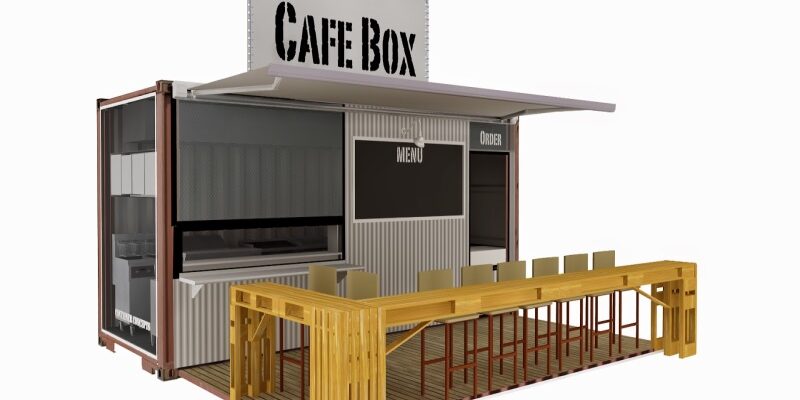
Have you ever considered the potential that simple structures like cargo shipping containers hold within the realm of architectural design and innovation? What if I told you that these metallic boxes are more than just storage units and have been repurposed into modern-day architectural marvels offering outstanding caffeine experiences? Stay with me as we take a journey into the thriving world of cool and trendy shipping container cafes.
Container cafes are popping up in every corner of the globe, proving that sustainability and practicality can beautifully merge with modernity and style. As we delve deeper, we’ll look at why this trend is gaining popularity and the various structural designs around the world where these container cafes have been successful.
In this post, we will also explore the benefits and disadvantages of using shipping containers for such purposes and weigh in some expert opinions. So sit back, grab a coffee (no pun intended!) and let’s dive into the realm of these fascinating upcycled structures.
Why Choose Shipping Containers?
A borrowed concept from the world of sustainable architecture, shipping container cafes are proving their mettle not only due to their unique aesthetic but also their affordability and flexibility. Because of their ubiquitous and standardized nature, these containers offer scope for creativity and innovation like few other building materials.
Moreover, sustainability has become a buzzword in the design world, and the shipping container fits right into this narrative. Instead of rusting in landfills or harbours, these containers are getting a second life, thereby reducing environmental impact significantly.
Within the second half of the 20th century, the concept of using these containers as building blocks has gained momentum. Today, they have become symbols of modern design, serving not just as cafes, but homes, offices, and even hotels.
Celebrated Shipping Container Cafes Around the World
Venture with me, as we explore the creativity found in shipping container cafes from different corners of the globe. Cafe eateries like Bangkok’s Artbox, Melbourne’s Common Ground Project, and London’s Pop Brixton demonstrate how these containers can be transformed into inviting, atmospheric spaces.
Each of these cafes has its unique flavour and character, ingeniously incorporating the industrial container look into their overall ambiance. From Australia to Thailand to the United Kingdom, these projects underscore how shipping containers can adapt to various climates and cultures, never once losing their aesthetic appeal.
Let’s not forget examples closer to home, like the Downtown Container Park in Las Vegas that boasts a distinctive artistic spirit, proving that the container cafe trend is not just an international phenomenon but is flourishing within our own American backyard as well.

Pros and Cons of Shipping Container Cafes
Like with any popular trend, the concept of shipping container cafes comes with its own set of advantages and drawbacks. Understanding these can help one make informed decisions about hopping onto this bandwagon.
Shipping containers are a much cheaper alternative to traditional construction, and their modular nature allows for customization and scalability. However, challenges may arise from local building regulations and thermal insulation requirements. Furthermore, although they offer a unique aesthetic, designing can be complex due to their long and narrow form.
Nailing the Design Aspects
Designing a shipping container cafe isn’t just about cost and sustainability; it must also meet the functional needs of a cafe. Factors like space utilization, customer flow, and atmosphere play a central role in the design process.
Experimenting with multiple containers, opening up spaces, and playing with heights can dramatically transform the spatial experience. Meanwhile, integrating elements like outdoor seating areas, glass walls, and creative lighting can help create an inviting and warm environment.
Looking into the Future
With the rise of sustainable living and growing environmental consciousness, the future of shipping container cafes appears promising. As architects, entrepreneurs, and customers become more appreciative of upcycled structures, these container cafes will continue to prosper, offering unique coffee experiences worldwide.
We can expect more innovative designs and better usage of this unconventional building material. Perhaps soon we’ll be seeing multi-story container cafes or entire container cafe chains. The possibilities, as they say, are endless.
Conclusion
Shipping container cafes are a fascinating fusion of sustainability, modern architectural design, and coffee culture. Despite the challenges faced, the benefits and the sheer creativity involved in these structures make them a winning solution. The case studies we’ve explored only serve to fuel the imagination of what lies ahead for these unconventional structures within the world of design.
In conclusion, shipping container cafes are not just a trend but a movement towards innovative, sustainable, and cost-effective design. As we band together to create a more sustainable world, it’s inspiring to see how the humble shipping container is contributing to this change, one cafe at a time.
Embrace the trend, celebrate the ingenuity, and, in doing so, you might just find yourself enjoying your next cup of coffee in a wonderfully designed shipping container cafe.










